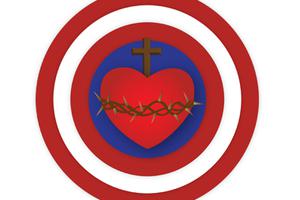Catholic History Anchors Biloxi-Gulf Coast
Churches Have Weathered Changes and Storms With Faith

St. Michael’s is a church without residents, says longtime parishioner Alan Santa Cruz. That’s because the church sitting right across the street from the Gulf of Mexico in Biloxi, Miss., was twice thrashed by hurricanes: Camille in 1969 and Katrina in 2005.
The two natural disasters not only beat up the physical church (plus the parish hall and Lourdes grotto), but also wiped out innumerable homes nearby, where parishioners resided. Yet despite all of the devastation, the parish remains vibrant and is popular with tourists.
Welcoming of All
“Our parish has always had a very warm, welcoming feel,” says Santa Cruz, noting it’s probably because the church has always been home to people of different nationalities.
St. Michael Church got its start in 1917, when it was opened to serve the throngs of immigrants streaming in to work the burgeoning local seafood industry: mainly Poles, Bohemians and Croatians. Dubbed the “Church of the Fisherman,” St. Michael’s began holding a ceremonial “Blessing of the Fleet” in 1929 at the start of Biloxi’s shrimping season, typically late May or early June. The boats would line up in rows, and the pastor would walk across the boats from bow to bow, blessing each one.
This practice was modified slightly after the pastor slipped and fell into the drink one year; now, the celebrant stands on an anchored “blessing boat,” and the shrimping vessels slowly glide past it to receive blessings for a safe journey and bountiful catch.
In 1964, St. Michael’s built a new church that emphasized its connection to the sea. The church was constructed in a cylindrical shape and topped with a scalloped shell roof, as was a tiny, adjacent chapel. Stained-glass windows, crafted in St. Louis, depicted the apostles grasping nets full of fish, reflecting the local industry and the fact that the apostles were “fishers of men.”
A few years later, when Camille slammed into the shores, the pastor safely rode out the storm in the church. But 36 years later, when Katrina hit, she hit much harder, shattering every window and shoving the 2.5-ton altar, crafted from stone quarried in the Holy Land, a full 30 feet.
But the parishioners weren’t cowed. They simply banded together once again to piece their beloved church back together. The stained-glass window company in St. Louis still had the plans for the original 1964 windows and re-created them. The altar was reset. Plans are in place to rebuild the grotto and parish hall. And volunteers like Santa Cruz and his wife, Joan, proudly give tours of their “church with no residents.”
Sts. Augustine and Rose
The Biloxi-Gulf Coast area is rich in Catholic African-American history. Two places not to miss are St. Augustine Seminary and St. Rose de Lima, both in Bay St. Louis, about 40 minutes west of Biloxi.
St. Augustine’s was the first seminary in the United States that accepted black men. Opened in 1920 in Greenville, Miss., it was moved to Bay St. Louis in 1923. Although the seminary is no longer in operation, its facilities are now used as a retirement center for the Divine Word Missionaries who established the seminary, plus as a retreat center. Visitors can stop in its red-brick chapel for prayer or Mass, as well as the adjacent Lourdes grotto, built in 1938.
St. Rose de Lima was established in 1926 to serve the local African-American population, and when it opened, it became Mississippi’s first African-American Catholic church. It also served many people of Indian heritage. In 1991, the church underwent a unique renovation to celebrate its heritage. Under the guidance of Father Ken Hamilton, the pastor, the altar’s base was created from a large piece of driftwood that had washed ashore near local St. Stanislaus College; the driftwood’s roots reach upward toward the heavens. Other trees found in the area were used to craft a new ambo, tabernacle stand and small table to hold the water and wine.
But the most stunning part of the renovation was the mural painted in the sanctuary. Titled “Christ in the Oak,” the art depicts an African Jesus suspended in air before a mighty, sprawling oak tree. According to the artist, the mural represents Jesus’ crucifixion and resurrection. It also shows — through roots solidly anchoring it into the ground, yet with branches stretching heavenward — how Christ is tied to the earth yet has also broken free.
In a nod to the church’s past and present, the names of all parishioners since the church’s inception are gracefully written above the tree’s thick branches. (Today, St. Rose’s parishioners have various ethnicities and heritages.)
Time your visit so you can participate in a Sunday Mass when the church’s Gospel choir will be singing. The nationally known St. Rose Gospel Choir generally sings every Sunday at 9am, although it is often on the road.
The Gulf region is still being rebuilt, and these Catholic anchors are leading the way.
Melanie McManus writes from Sun Prairie, Wisconsin.
INFORMATION
St. Michael Church: Tours Tuesday-Thursday from 12-3pm. Call (228) 435-5578.
St. Augustine Seminary: Morning prayer at 7am, followed by Mass, Monday-Saturday.
Sunday Mass is at 9am. Call (228) 467-6414.
St. Rose Church: Tours by appointment. Contact the Hancock County Tourism Development Bureau at (800) 466-9048.
- Keywords:
- July 13-26, 2014
















